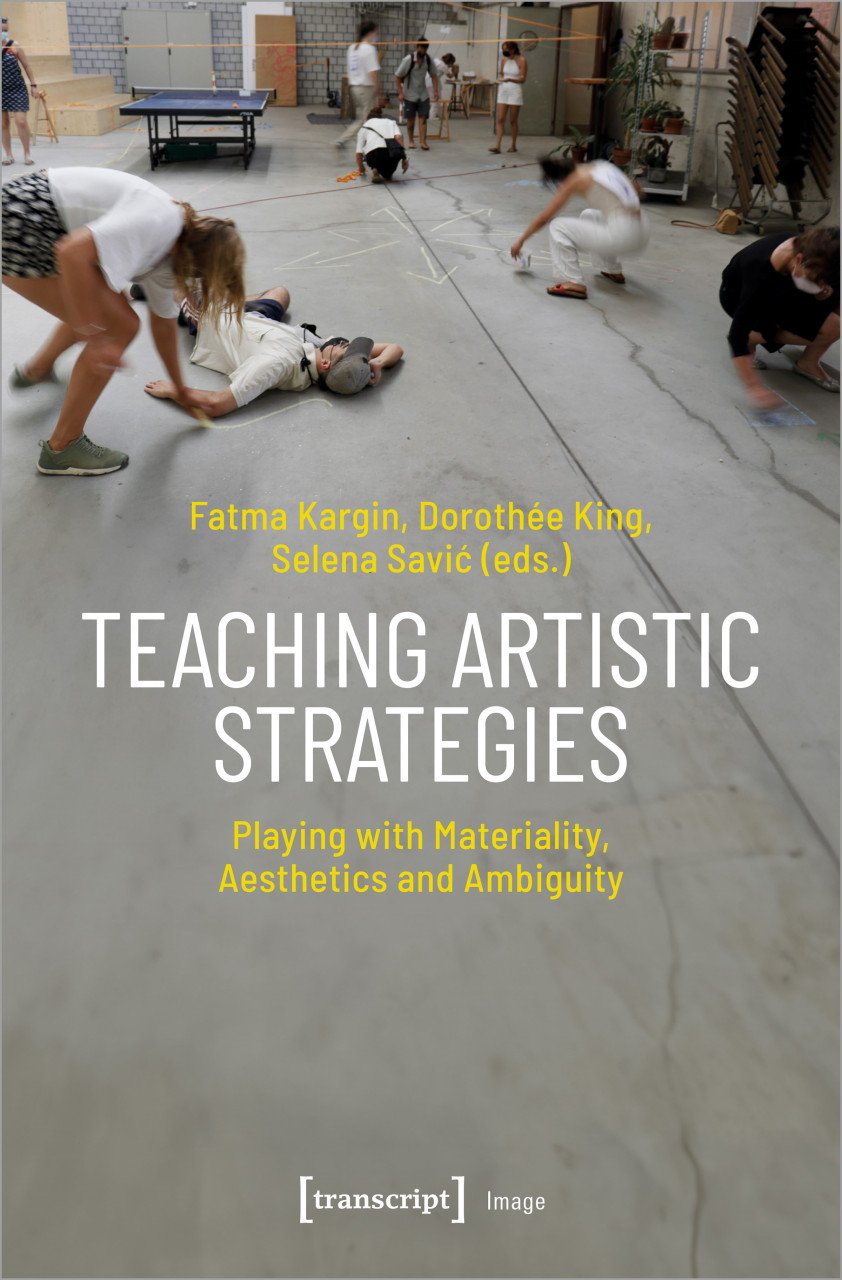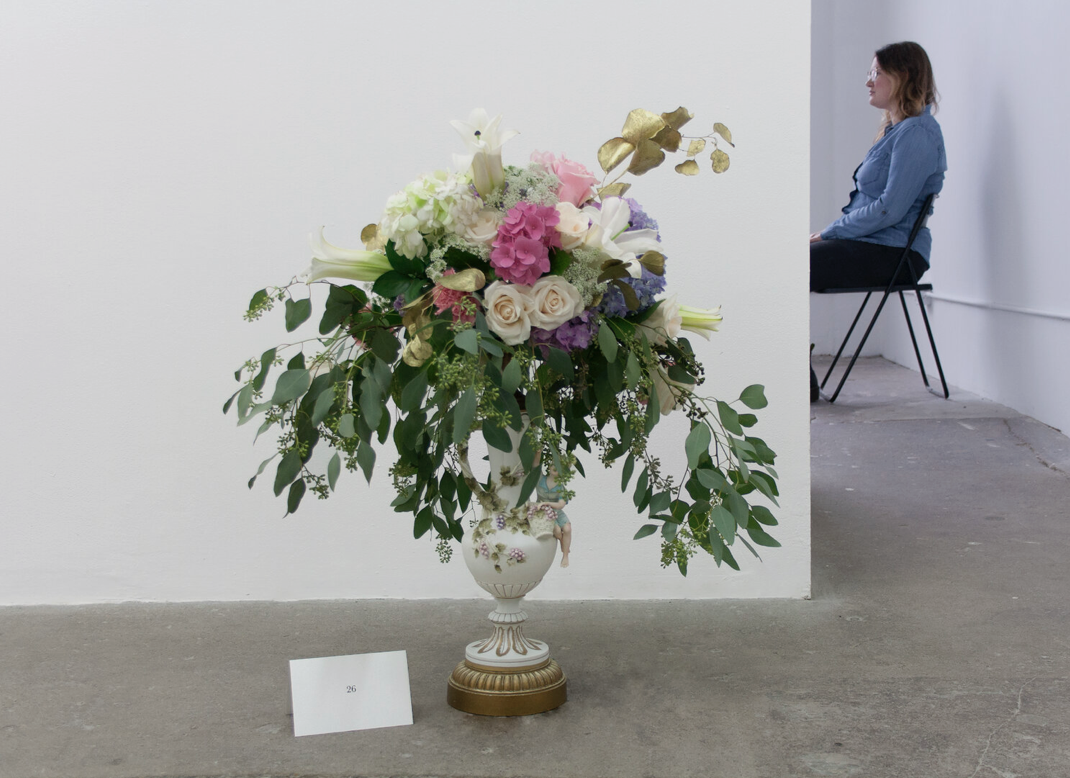Writing is one way of magic to shift our perception. I offer experimental perspectives on artistic practices, creative living, and contemplation techniques. Even my academic papers are an invitation to live courage, spaciousness, and humorous self-realization.
My first monograph Smell Art! was published in German in 2016. My research on digital graffiti appeared in the Int|AR Journal 09. My writings are published with Routledge, the Journal for Curatorial Studies, and other international peer-review journals, and edited volumes.
I have co-edited three larger book projects: Teaching Artistic Strategies: Playing with Materiality, Aesthetics, and Ambiguity (forthcoming 2024), Playtest (2013), which features essays on experimental approaches in interdisciplinary art and artistic research, and Interface Cultures (2008), a compendium on interactive interfaces in electronic art.
Please find my publications on arts, design, and education below.
Teaching Artistic Strategies: Playing with Materiality, Aesthetics, and Ambiguity
Kargin, Fatma; King, Dorothée; Savic, Selena: Teaching Artistic Strategies: Playing with Materiality, Aesthetics, and Ambiguity, transcript, 2024.
Artistic strategies have a great transformative potential to improve research, teaching, and artistic expression. The contributors to this volume show how to unleash this potential by presenting a variety of epistemological experiments at the intersection of artistic research, pedagogy, and innovative practices in art and design education.
Collaborating Lines
Xavier Veilhan interviewed by Dorothée King
On a summer day in 2022, I visited the Musée d’Art Moderne de la Ville de Paris. I was drawn into and intrigued by the diverse simplicity and the all-embracing beauty of the colorful lines of Xavier Veilhan’s A3-sized ink-on-paper lockdown drawings, shown in his solo exhibition The Lockdown Drawings. So far, I only knew about Xavier’s bright, bold, and volumetric installations. I wanted to learn more about Xavier’s thought processes about the 2-dimensional space and his interest in lines…(Published at The Nomadic Journal)
Mindfulness and Meditation
Maybe you feel like most of all (art) students: Do you feel drained from all the digital input you are supposed to deliver, and all the digital output of others you consume? How does this affect your own creativity? In these digital times, do you also ask yourself how to deliver content, catch up with everyone, motivate yourselves, inspire others, stay creative, stay on track, stimulate discussion, be high-level intellectually, and deliver artistic excellence?
Homeland Smells. Matt Morris’ olfactory art works
King, Dorothée and Morris, Matt in Conversation: Copycat Kill or Smelling a Sense of Home. In Burchert, Linn: Atem. Breath, Berlin: De Gruyter, 2021. 235-244.
For a long time, I have been fascinated by the artistic and participatory possibilities of ephemeral materials in exhibition contexts. I have been researching the social and aesthetic implications of sensory experiences in various museum projects, classrooms, and publications. In 2018 I met the artist Matt Morris at the 106th College Art Association conference in Los Angeles, for which our smell-art-loving colleagues Debra Parr and Gwen-Aël Lynn organized a panel on “Olfactory Art and the Political.”
Digital Graffiti
King, Dorothée: Digital Graffiti, in 10 years of Int|AR Compilation, Basel: Birkhäuser, 2021, 30-37.
Materialwerte - Ideen materialisieren, Sinne vernetzen
Ein Gespräch mit Lisbeth Freiss und Dorothée King, p.146-163. In Nicole Berner / Anna Maria LoffredoGrenzen öffnen – Werte prüfen: Bildungswerte und Wertebildung in der KunstdidaktikTransdisziplinäre Entwürfe und Ergebnisse einer bilateralen Online-Ringvorlesung, München: Kopäd 2021.
Making Art Schools
A Reader by Dorothée King, edited by Bernhard Garnicnig, 2020/2021
Some say that art can be neither taught nor learned. If this is true, then perhaps the institutions, places, and communities we know as art schools exist to learn and teach the art of making (art) schools? What kind of histories would inform such programs, and what styles and practices serve as orientation for those eager to learn such an art? This reader assembles histories of the development of systems and nomenclatures of art and design schools and schooling around the globe.
Can we breathe?
KING, D.: Can we breathe?, In: Parr, Debra; Lynn, Gwen, Olfactory Art and The Political in an Age of Resistance, Routledge, 2021.
Learning Lab Arts and Design
King, Dorothée: Learning Lab Arts and Design, in: Renner, Michael (Ed.): Re-Use, Basel, 2020.
Whose Skin? Curating Tattooed Tableaux Vivants in Contemporary Art
KING, D. (2019), ‘Whose Skin? Curating Tattooed Tableaux Vivants in Contemporary Art’, Journal of Curatorial Studies, 8:1, pp. 6–21, doi: 10.1386/jcs.8.1.6_1 (peer review)
Learning Lab Arts and Design: Re-Processing the Future of Art and Design Education
King, Dorothée: Learning Lab Arts and Design: Re-Processing the Future of Art and Design Education, in: Langkilde, Kirsten (Ed.): Imagine, Basel, 2019, 127-136.
Lernen von Kunst und Design im Labor: Eine Datensammlung früherer Kunst- und Designausbildungen
KING, D. (2019): Lernen von Kunst und Design im Labor: Eine Datensammlung früherer Kunst- und Designausbildungen, ART EDUCATION RESEARCH, e Journal SFKP No 16, November 23, 2019.
Digital Graffiti
King, D.: Digital Graffiti, in Int|AR Journal 09 ‘Design Intervention as ACT, 2018, p.82-89. Peer review article.
Contemporary Art, M 204, Carb I, by Jackie Ferrara, 1980
King, Dorothée: Contemporary Art, M 204, Carb I, by Jackie Ferrara, 1980, in: Toby Rossner and Carol Gibson-Prugh (Ed.): RISD Museum Docent Viewpoint, September 2017.
Immersion into the Uncanny vs. Established Aesthetic Experiences - on the change of interface and imagery in video art games
King, Dorothée: Immersion into the Uncanny vs. Established Aesthetic Experiences - on the change of interface and imagery in video art games, in “In and Out of Art History: The Video Games Conundrum”, LEA (The MIT Press) Special Issue, 2018.
Kunst riechen! [Smell Art!]
King, Dorothée: Kunst riechen! [Smell Art!], Oberhausen 2016. Monograph.
Kunst riechen untersucht Geruch in der jüngeren bildenden Kunst, um die Frage zu beantworten, wie olfaktorische Kunst vermittelt werden kann. Ausgangspunkt sind künstlerische Strategien und Werke von Künstlern der (zeitgenössischen) bildenden Kunst, die Aroma und Geruch bewusst in ihren Arbeiten in Gebrauch nehmen. Analysiert werden Werke von Marcel Duchamp, Wolfgang Laib, Anya Gallaccio, Carsten Höller, Dan Mihaltianu, Teresa Margolles, Sissel Tolaas, Olafur Eliasson, Karla Black, Bruce Nauman, Peter DeCupere, Sabotage Communications, Jenny Marketou, Carrie Paterson und Wolfgang Georgsdorf.
Nine Works: Die Graduiertenschule für die Künste der Universität der Künste Berlin
Die Graduiertenschule für die Künste: Nine Works: Die Graduiertenschule für die Künste der Universität der Künste Berlin, Berlin 2014.
»Feel it«. Aus Einfühlungsästhetik wird Fühlästhetik
King, Dorothée: »Feel it«. Aus Einfühlungsästhetik wird Fühlästhetik. Positionen aus der zeitgenössischen bildenden Kunst, in Susanne Stemmler (Ed.): Objektivität und Subjektivität in den Künsten und den Wissenschaften, Berlin/Zürich 2014.
Lidschatten, Staub und Katzenfutter. Forschende Zugänge zu Alltagsmaterialien in Bezug zu Werken der »artistic research«
King, Dorothée: Lidschatten, Staub und Katzenfutter. Forschende Zugänge zu Alltagsmaterialien in Bezug zu Werken der »artistic research« in: Kirsten Winderlich (Ed.): grund_schule Kunst Bildung: band 2 material. Oberhausen 2014, 25-36.
Sensorimotor Contingencies. Kunstvermittlung und Gestaltung ästhetischer Erfahrung
King, Dorothée: Sensorimotor Contingencies. Kunstvermittlung und Gestaltung ästhetischer Erfahrung, in: Lang, Siglinde (Ed.): CfA: p/art/icipate #03 – GO PUBLIC! Art, Communication and the Public- ART MEDIATION PERSPECTIVE, Salzburg 2013, http://www.p-art-icipate.net/cms/sensorimotor-contingencies/















![Kunst riechen! [Smell Art!]](https://images.squarespace-cdn.com/content/v1/5eb6b7ed7b841b6ace9d8b12/1618919622642-FKY2Z82C1M6EGGFVBZ1S/kunsriechen.jpg)



